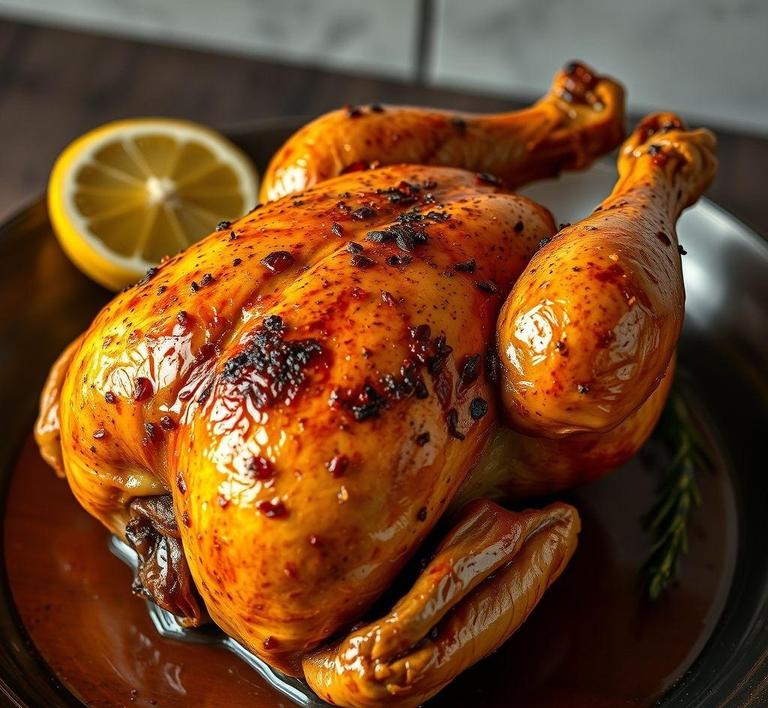So, you’ve got some leftover roasted chicken and you’re wondering, “Can I refreeze it”? Well, you’re not alone! Many people end up with extra chicken after a big meal or a family dinner, and the good news is, you can absolutely refreeze it – as long as it’s done right. Refreezing roasted chicken can help you save time and avoid waste, but there are a few important steps to keep in mind to ensure it’s safe and stays tasty. In this guide, we’ll walk you through everything you need to know about refreezing roasted chicken, from how to store it properly to the best way to reheat it later. So, let’s dive in and make sure that chicken stays just as delicious the second time around!
Can You Refreeze Roasted Chicken?

When it comes to refreezing roasted chicken, the answer is nuanced and hinges on several critical factors related to food safety and quality. In principle, it is possible to refreeze roasted chicken, but with important caveats to keep in mind. The key consideration is whether the chicken has been handled properly after cooking and whether it has been kept at a safe temperature throughout.
The U.S. Department of Agriculture (USDA) guidelines say that if roasted chicken has been thawed in the refrigerator and has not been left out at room temperature for more than two hours, it can be safely refrozen. This is because the cold environment of the refrigerator (typically below 40°F or 4°C) slows bacterial growth significantly, preventing spoilage and contamination. However, if the chicken has been sitting out for an extended period or was thawed using faster methods (like the microwave or cold water), refreezing is not recommended due to potential bacterial proliferation.
Additionally, if the roasted chicken has already been frozen once and then thawed properly, refreezing can be done but may affect the texture and moisture content. The more times chicken cycles through freezing and thawing, the more cell structure breaks down, which impacts the overall eating experience.
In short, yes, you can refreeze roasted chicken, but only if it has been handled and stored correctly to minimize health risks and maintain its edible quality.
How To Refreeze Roasted Chicken?
Refreezing roasted chicken requires careful steps to ensure both safety and as much retention of flavor and texture as possible. Here’s a detailed, step-by-step process:
-
Cool the Chicken Completely
Before freezing, the roasted chicken should be cooled completely to room temperature-but not left out longer than two hours to avoid bacterial growth. Ideally, transfer the chicken to the refrigerator to cool down rapidly.
-
Use Proper Packaging
Wrap the chicken tightly in freezer-safe materials. This could include heavy-duty aluminum foil, plastic wrap, or vacuum-sealed bags. Proper packaging prevents freezer burn, which dehydrates and toughens the meat. Removing as much air as possible is crucial.
-
Portion Control
Consider dividing the chicken into smaller portions before freezing again. This helps with thawing only what you need later and minimizes repeated freeze-thaw cycles that degrade quality.
-
Label and Date
Use a marker to label the package with the date of freezing. This is essential for keeping track of how long the chicken has been stored, as refrozen cooked chicken is best consumed within 1 to 2 months for optimal quality.
-
Freeze Promptly
Place the packaged chicken in the coldest part of the freezer as soon as possible. The faster the freezing, the smaller the ice crystals formed inside the meat, which helps maintain texture.
-
Thaw Safely When Ready to Use
When you want to use the refrozen roasted chicken, thaw it in the refrigerator overnight or use safe thawing methods like microwave defrost or cold water immersion, but cook or consume immediately afterward to avoid bacterial risk.
Quality Impact
Refreezing roasted chicken, while safe under the right conditions, almost inevitably affects its quality, sometimes noticeably. The main culprit is the ice crystals formed during freezing. When chicken is frozen, water inside the meat cells expands and forms ice crystals. These crystals can rupture the cell walls, causing moisture to leak out during thawing, which results in drier, less juicy meat.
With each cycle of freezing, thawing, and refreezing, this damage accumulates, and the chicken’s texture can become grainy or rubbery. The skin, if still present, may lose its crispness and become chewy or leathery after reheating. Additionally, flavor compounds can degrade or be lost with moisture, making the chicken taste less fresh or somewhat bland.
Freezer burn is another common quality issue that arises when chicken isn’t wrapped tightly enough. This causes dry spots, discoloration, and off-flavors that detract from the enjoyment of the meal.
However, if you reheat the chicken carefully-using low, even heat or incorporating it into stews, soups, or casseroles-the texture and taste can be preserved or even enhanced by the other ingredients and cooking methods.
Refreezing roasted chicken is a practical option to reduce food waste and extend the life of your cooked meals, but it comes with important considerations. Ensuring the chicken was thawed safely in the refrigerator and has not been exposed to unsafe temperatures is paramount for food safety. Proper packaging and rapid freezing will help protect the chicken from freezer burn and preserve its quality.
Though refreezing can affect texture and flavor-leading to drier, less tender meat-the impact can be minimized with careful handling and by incorporating the chicken into dishes where moisture and seasoning help mask any loss of quality. Ultimately, refreezing roasted chicken is a balancing act between convenience, safety, and culinary enjoyment. With mindful practices, it’s a viable way to enjoy your leftovers without compromise.
Is It Safe To Refreeze Roasted Chicken?
When it comes to food safety, one of the most common questions is whether you can safely refreeze roasted chicken. The answer depends on several key factors-temperature, time, and handling. Roasted chicken, when cooked properly and cooled promptly, can indeed be refrozen safely, but only under the right conditions.
Firstly, the safety hinges on how the chicken was handled after cooking. If the roasted chicken was refrigerated within two hours of cooking, and has remained at a safe temperature (below 40°F or 4°C), refreezing is generally safe. This is because the low temperature prevents bacteria from multiplying to dangerous levels. However, if the chicken has been left out at room temperature for more than two hours, or if it was thawed and kept at unsafe temperatures, refreezing can lead to foodborne illness.
Another factor is the texture and quality of the chicken after refreezing. Freezing causes water crystals to form inside the meat fibers, which can rupture the structure, leading to a loss of moisture and a dryer texture once cooked again. While this doesn’t make the chicken unsafe, it may impact the eating experience.
In summary, yes-you can refreeze roasted chicken safely if it was handled properly, kept at safe temperatures, and has not been left out for too long. However, always prioritize safety over convenience.
Signs That Roasted Chicken Should Not Be Refrozen
It’s crucial to recognize when roasted chicken should not be refrozen. Ignoring these signs can risk foodborne illnesses and spoil the taste and texture of your food. Here are the key indicators:
- Unpleasant Odor: Fresh roasted chicken has a mild, savory aroma. If your chicken smells sour, rancid, or “off”, that’s a clear sign that bacteria have proliferated, and it’s unsafe to refreeze.
- Slimy or Sticky Texture: If the surface of the chicken feels slimy or sticky, this can indicate bacterial growth. This is a major red flag.
- Discoloration: Fresh cooked chicken typically has a consistent white or light brown color. Grayish, greenish, or any other unusual hues are warning signs of spoilage.
- Left Out at Room Temperature Too Long: If the chicken has been sitting out at room temperature for more than two hours (or one hour in hot climates above 90°F/32°C), it’s unsafe to refreeze or consume.
- Already Thawed Multiple Times: If the chicken has been thawed and refrozen repeatedly, the quality degrades drastically, and the risk of bacterial contamination rises significantly.
If any of these signs are present, it’s best to discard the chicken rather than risk your health by refreezing or consuming it.
Common Refreezing Mistakes
Even experienced home cooks make mistakes when refreezing roasted chicken. Here’s a rundown of common pitfalls to avoid:
- Refreezing Without Cooling Properly: Putting warm or hot roasted chicken directly into the freezer is a no-no. It raises the freezer temperature and can create a breeding ground for bacteria. Always cool your chicken in the fridge first.
- Ignoring the Two-Hour Rule: Leaving cooked chicken out at room temperature for more than two hours allows bacteria like Salmonella and Clostridium perfringens to multiply rapidly, increasing food poisoning risks.
- Refreezing Multiple Times: Each freeze-thaw cycle deteriorates the chicken’s texture and flavor. It also increases bacterial risks if the chicken is not kept at proper temperatures between cycles.
- Packaging Improperly: Using packaging that doesn’t seal out air causes freezer burn, drying out the chicken and ruining its taste. Use airtight containers or vacuum-seal bags for best results.
- Not Labeling: Without a clear label showing the freezing date, you may keep chicken in the freezer too long, exceeding the recommended storage time (usually 3-4 months for best quality).
By avoiding these mistakes, you ensure that your refrozen roasted chicken remains safe, tasty, and nutritious.
Tips And Tricks
To make the most of your roasted chicken and refreezing process, here are some practical tips and tricks:
- Cool Quickly: After roasting, slice or shred the chicken to allow it to cool faster in the refrigerator. This minimizes the time in the ‘danger zone’ (40°F-140°F).
- Divide into Portions: Freeze in meal-sized portions to avoid repeatedly thawing and refreezing large chunks.
- Use Quality Packaging: Vacuum seal or tightly wrap chicken in plastic wrap followed by aluminum foil to protect against freezer burn.
- Label Everything: Include the date and contents on each package. This keeps your freezer organized and helps avoid food waste.
- Thaw Safely: Always thaw frozen chicken in the refrigerator, not on the counter. This prevents bacterial growth.
- Reheat Thoroughly: When ready to eat, reheat chicken to an internal temperature of 165°F (74°C) to kill any lingering bacteria.
- Freeze Leftovers Promptly: Don’t let leftover roasted chicken linger in the fridge for more than 3-4 days before freezing.
Conclusion
Refreezing roasted chicken is entirely possible-and safe-when done mindfully. The key lies in how the chicken was handled, how quickly it was cooled, and whether it remained at safe temperatures. Understanding the signs of spoilage and avoiding common refreezing mistakes will protect your health and preserve the flavor and texture of your chicken.
By following simple tips-cooling chicken promptly, using airtight packaging, labeling properly, and reheating thoroughly-you can confidently extend the shelf life of your delicious roasted chicken without compromise. When in doubt, always prioritize safety over saving leftovers to ensure every bite you take is both tasty and safe.


